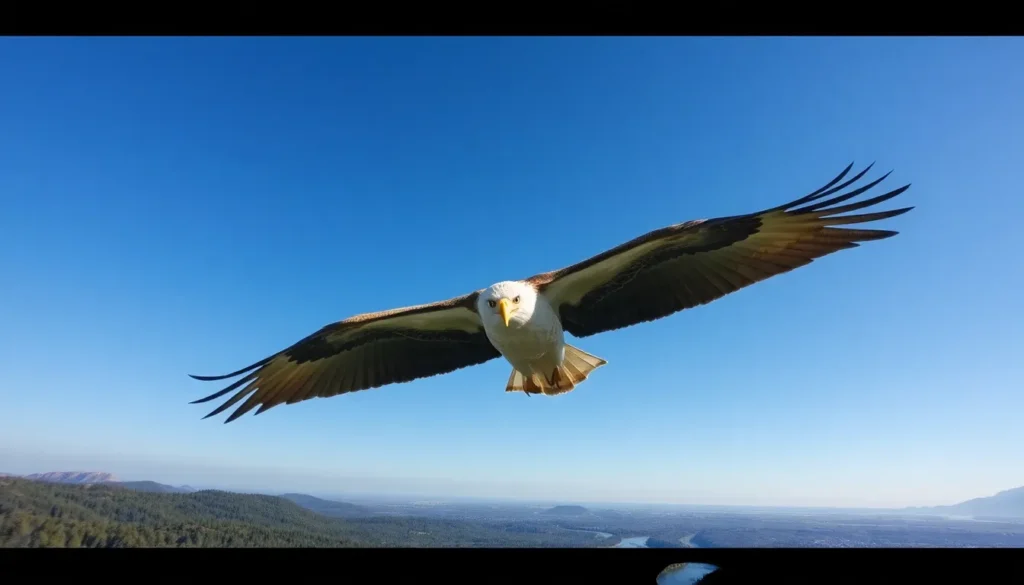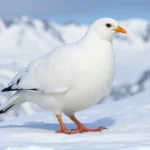We’ve all gazed up at the sky and marveled at the effortless grace of birds soaring through the air. Bird flight represents one of nature’s most remarkable achievements – a complex dance of aerodynamics, biology, and evolutionary perfection that’s captivated humans for millennia.
From the powerful wingbeats of eagles to the delicate flutter of hummingbirds, each species has developed unique flying techniques that showcase nature’s incredible engineering. Understanding how birds achieve flight reveals fascinating insights into wing mechanics, air currents, and the specialized anatomical features that make aerial mastery possible.
Whether you’re a curious nature enthusiast or someone seeking deeper knowledge about avian locomotion, we’ll explore the science behind this extraordinary ability that continues to inspire human innovation in aviation and beyond.
Understanding the Mechanics of Bird Flying
The intricate mechanics of bird flight rely on a perfect combination of specialized anatomy and physics. We’ll explore the fundamental components that make avian flight possible.
Wing Structure and Aerodynamics
Wings generate lift through their unique curved shape and positioning. The upper surface of a bird’s wing creates faster airflow compared to the lower surface, resulting in lower pressure above and higher pressure below. This pressure difference produces the upward force we call lift.
Different wing shapes serve exact flight purposes. Eagles and hawks possess broad wings with slotted tips that excel at soaring and gliding. Falcons feature narrow, pointed wings designed for high speed diving and rapid directional changes. Hummingbirds showcase short, rounded wings that enable hovering and backwards flight.
Wing loading affects flight efficiency and maneuverability. Birds with high wing loading, like ducks, require faster speeds to maintain flight but achieve greater energy efficiency during long distance travel. Species with low wing loading, such as owls, can fly silently at slower speeds but use more energy per mile traveled.
Muscle Power and Energy Requirements
Flight muscles comprise 15 to 25 percent of a bird’s total body weight. The pectoralis major muscle powers the downstroke, while the supracoracoideus muscle controls the upstroke through a unique pulley system involving the coracoid bone.
Energy demands vary dramatically based on flight style. Hummingbirds consume up to 10 times their body weight in nectar daily to fuel their energy intensive hovering flight. Large soaring birds like albatrosses expend minimal energy by utilizing wind currents and thermals for extended periods.
Metabolic adaptations support sustained flight performance. Birds possess enlarged hearts that pump oxygen rich blood more efficiently during flight. Their respiratory system includes air sacs that provide continuous oxygen flow through the lungs during both inhalation and exhalation phases.
Role of Feathers in Flight Control
Primary feathers act as individual propeller blades during wing beats. These outer wing feathers can be adjusted independently to fine tune thrust and lift generation. Birds spread or close these feathers to modify wing area and shape based on flight conditions.
Tail feathers function as both rudder and brake during flight maneuvers. Spreading the tail increases drag for landing approaches, while fanning it to one side creates turning forces. Birds also use tail positioning to maintain stability during turbulent conditions.
Contour feathers create the smooth airfoil shape essential for efficient flight. These overlapping feathers reduce air turbulence across the wing surface and can be raised or flattened to adjust aerodynamic properties. Specialized covert feathers fill gaps between larger flight feathers to maintain optimal airflow patterns.
Discovering Different Bird Flying Styles
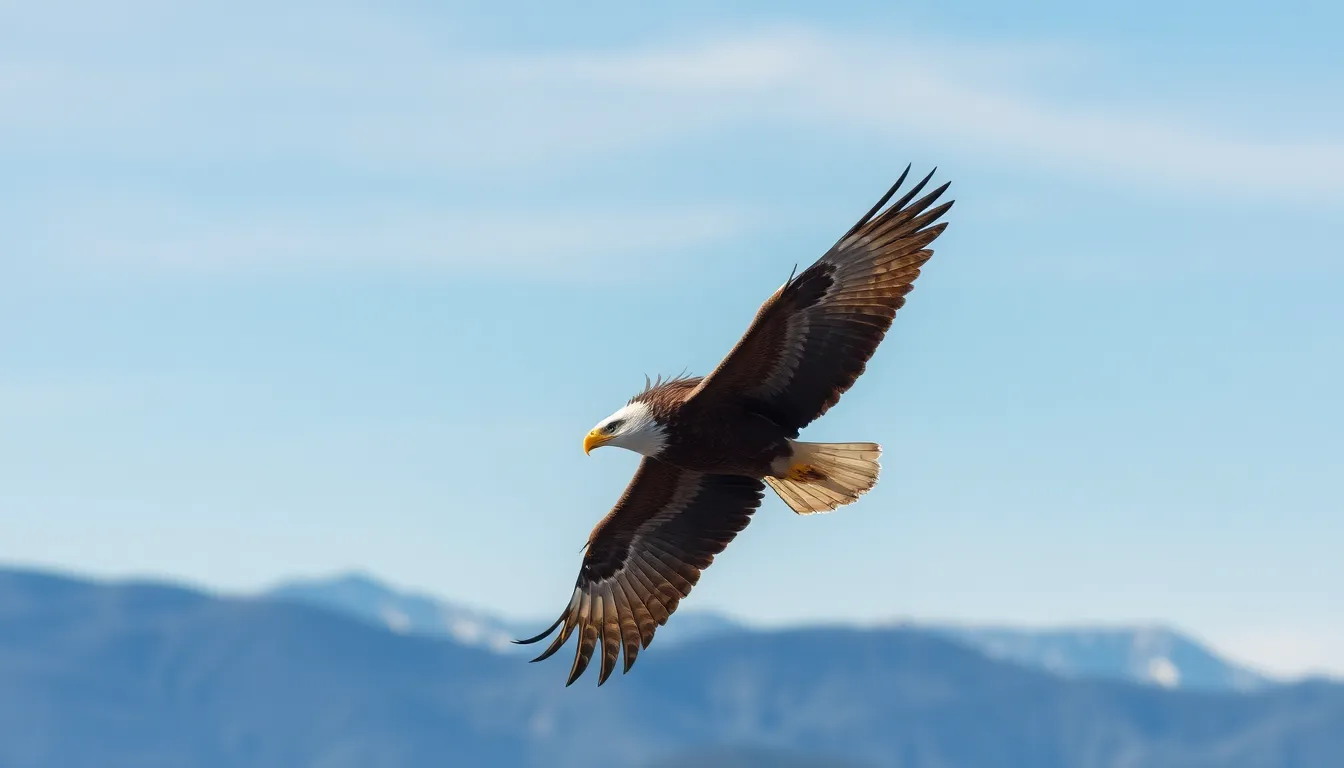
We observe remarkable diversity in how birds navigate the skies, with each species developing unique flight techniques suited to their environment and lifestyle needs.
Soaring and Gliding Techniques
Thermal soaring allows birds like eagles and hawks to ride rising warm air columns without expending energy. We see these magnificent birds spread their broad wings wide, using their primary feathers as individual winglets to adjust lift and maintain stability. Ridge soaring occurs when birds like gulls and vultures exploit air currents deflected upward by cliffs, hills, and mountain ridges.
Ever-changing soaring showcases the incredible efficiency of seabirds such as albatrosses, which harness wind gradients over ocean waves. These birds can travel thousands of miles with minimal wing flapping by alternating between high and low altitude flight zones. Slope soaring techniques enable birds to maintain altitude by flying parallel to wind-facing slopes, extracting energy from horizontal air movement.
We notice that soaring birds possess exact wing adaptations including high aspect ratios, slotted wing tips, and lightweight bone structures. Turkey vultures demonstrate exceptional soaring skills by detecting thermals through their acute sense of smell while riding air currents for hours without landing.
Flapping Flight Patterns
Continuous flapping characterizes small songbirds like sparrows and finches, which beat their wings rapidly throughout flight to maintain lift and propulsion. We observe wing beat frequencies ranging from 5 beats per second in crows to over 80 beats per second in bee hummingbirds. Bounding flight patterns appear in woodpeckers and many small passerines, creating an undulating flight path as birds alternate between flapping phases and brief gliding periods.
Formation flying demonstrates sophisticated flapping coordination in species like geese and pelicans, which position themselves to benefit from wingtip vortices created by adjacent birds. We measure energy savings of up to 25% for birds flying in V formations compared to solo flight. Power diving combines gravity with controlled flapping as peregrine falcons reach speeds exceeding 240 mph during hunting strikes.
Burst and glide techniques allow larger birds like ravens and hawks to intersperse powerful wing beats with extended gliding phases. We find this flight style particularly efficient for covering long distances while conserving energy reserves needed for other activities.
Hovering Abilities
True hovering requires birds to generate lift purely through wing motion without forward momentum, a skill mastered by hummingbirds through figure-eight wing patterns. We observe these tiny birds beating their wings up to 100 times per second while rotating them at the shoulder joint to create lift on both upstroke and downstroke. Wind hovering enables birds like kestrels and terns to maintain stationary positions by flying into headwinds at precisely the right speed.
Helicopter hovering occurs when birds like kingfishers and some hawks briefly suspend themselves over water or prey using rapid, shallow wing beats. We notice these birds adjust their body angle and wing position to counteract forward momentum while maintaining altitude. Assisted hovering involves birds using updrafts from cliffs or buildings to reduce the energy cost of remaining airborne in one location.
Precision hovering allows hummingbirds to feed from flowers while maintaining exact positioning, rotating their wings through 180 degrees to generate thrust in multiple directions. We find that hovering flight demands up to 10 times more energy than forward flight, explaining why only specialized species have evolved this remarkable ability.
Exploring Migration Patterns Through Bird Flying
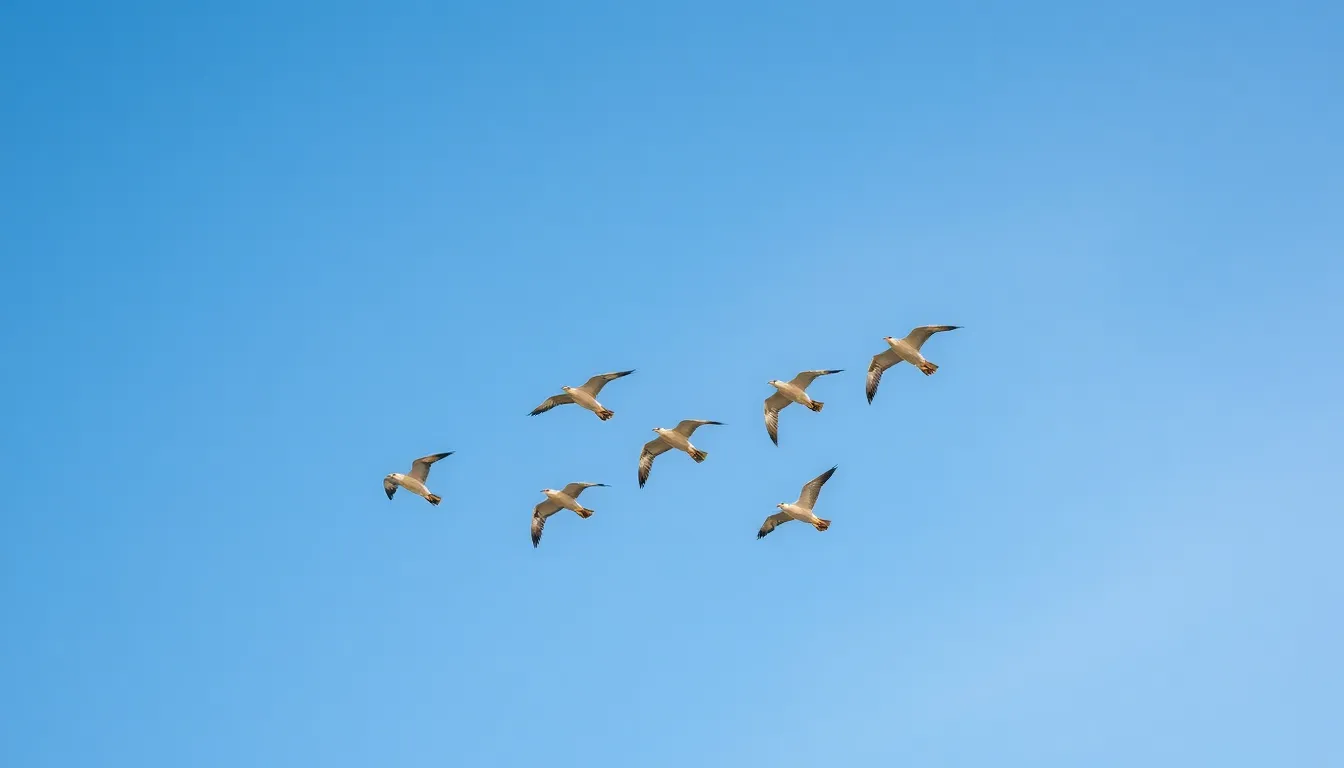
Migration represents one of nature’s most extraordinary displays of endurance and navigation precision. We witness billions of birds undertaking these incredible journeys across continents each year.
Long-Distance Flight Routes
Arctic terns complete the longest migration routes on Earth, traveling roughly 44,000 miles annually from Arctic breeding grounds to Antarctic feeding areas. These remarkable seabirds experience two summers each year as they chase optimal daylight conditions across both hemispheres.
Bar-tailed godwits demonstrate exceptional nonstop flying capabilities during their Pacific crossing from Alaska to New Zealand. Individual birds cover approximately 7,000 miles in a single flight lasting 8 to 9 days without rest or food.
Ruby-throated hummingbirds accomplish seemingly impossible feats by crossing the Gulf of Mexico during their migrations. Even though weighing only 3 to 4 grams, these tiny birds fly 500 miles nonstop across open water twice yearly.
Swainson’s hawks follow one of the most concentrated migration corridors, with over 1 million birds funneling through Panama each fall. Their 6,000-mile journey from North American breeding grounds to Argentine wintering areas showcases the power of thermal soaring for long-distance travel.
Navigation Methods During Flight
Magnetic field detection serves as birds’ primary navigation system through specialized cells containing magnetite crystals in their beaks and eyes. Scientists have discovered that these magnetic sensors help birds create internal compass readings even during cloudy conditions.
Celestial navigation relies on sun positioning during daytime flights and star patterns during nocturnal migrations. Migratory birds possess an internal clock that compensates for the sun’s movement throughout the day, maintaining accurate directional heading.
Landmark recognition becomes crucial during the final stages of migration when birds approach familiar territories. Coastal features, mountain ranges, and river systems provide visual reference points that guide birds to exact breeding or wintering locations.
Infrasound detection allows birds to perceive low-frequency sound waves from distant weather systems and geographical features. This acoustic navigation helps migrating flocks avoid storms and locate favorable wind conditions hundreds of miles away.
Seasonal Flying Behaviors
Spring migration timing connects directly to breeding success, with many species arriving at nesting grounds when food resources reach peak availability. Insectivorous birds like warblers time their flights to coincide with insect emergence patterns in northern latitudes.
Fall departure schedules vary dramatically between species, with some birds leaving breeding areas as early as July while others remain until November. Adult birds often migrate weeks before juveniles, allowing young birds additional time to develop flying strength and navigation skills.
Altitude adjustments during seasonal flights help birds optimize energy efficiency and avoid adverse weather conditions. Geese and cranes regularly fly at altitudes exceeding 20,000 feet, while smaller songbirds typically maintain elevations below 3,000 feet during migration.
Stopover strategies play critical roles in successful migration completion, with birds requiring exact habitat types for refueling during long journeys. Coastal wetlands, forest edges, and grassland areas serve as essential rest stops where migrants replenish fat reserves and recover from flight exertion.
Examining Speed Records in Bird Flying
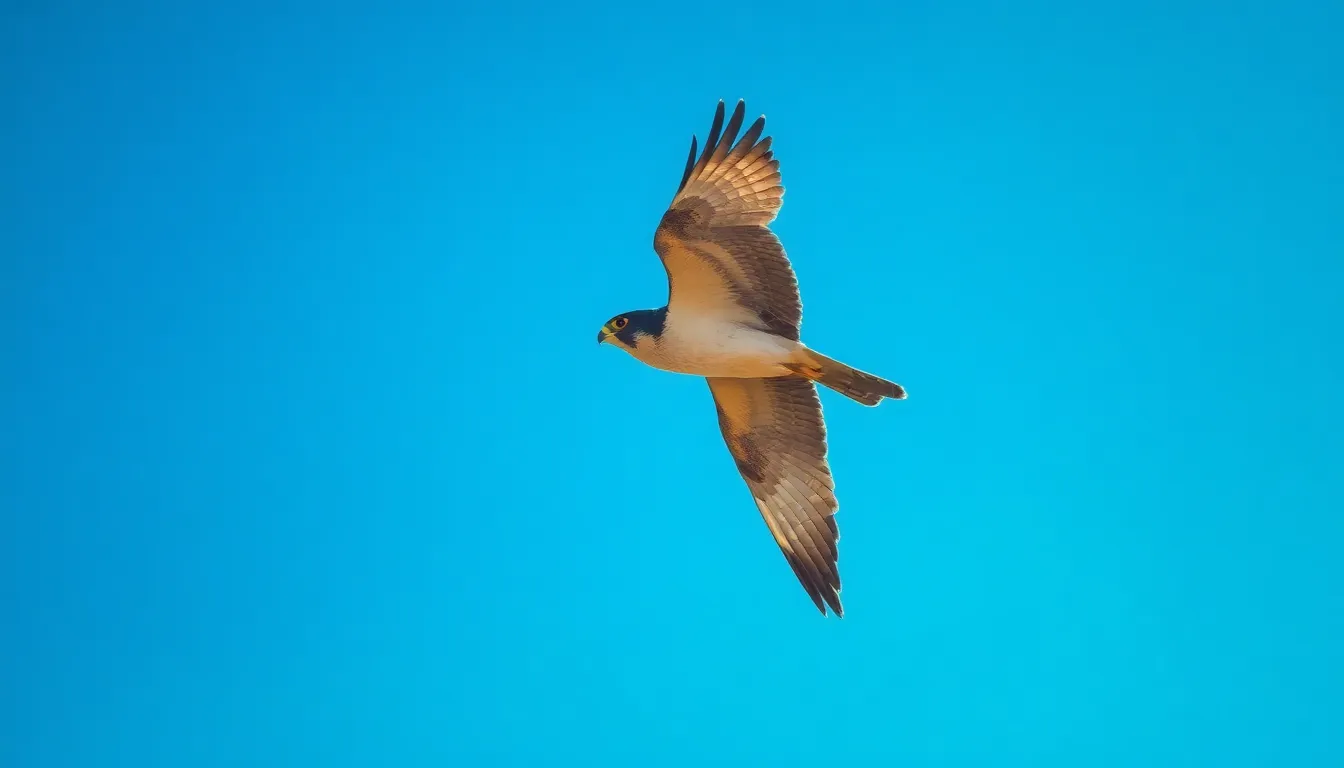
We’ve explored the mechanics and diversity of bird flight, and now we’ll examine the remarkable speed achievements that showcase the ultimate performance capabilities of avian flying.
Fastest Flying Birds in Level Flight
Peregrine falcons hold the title for fastest sustained horizontal flight, reaching speeds of 69 mph (111 km/h) during level flight. These aerial hunters combine streamlined body design with powerful wing beats to achieve their impressive velocities while pursuing prey across open landscapes.
Golden eagles demonstrate remarkable speed consistency, maintaining level flight speeds of 50-60 mph (80-97 km/h) during hunting expeditions. Their broad wings and muscular build allow them to sustain high speeds while scanning vast territories for potential meals.
Gyrfalcons excel in cold climate speed records, achieving horizontal flight speeds of 68 mph (109 km/h) in Arctic conditions. These powerful raptors use their substantial wing area and robust flight muscles to cut through dense air at high latitudes.
White-throated needletails represent the speed champions among small birds, reaching level flight speeds of 105 mph (169 km/h). Their crescent-shaped wings and lightweight bodies create the perfect combination for high-speed aerial maneuvers.
| Bird Species | Level Flight Speed | Habitat |
|---|---|---|
| White-throated Needletail | 105 mph (169 km/h) | Asia |
| Peregrine Falcon | 69 mph (111 km/h) | Global |
| Gyrfalcon | 68 mph (109 km/h) | Arctic |
| Golden Eagle | 60 mph (97 km/h) | Mountains |
Diving Speed Champions
Peregrine falcons dominate diving speed records, plummeting toward prey at speeds exceeding 240 mph (386 km/h) during hunting stoops. These incredible velocities result from their streamlined body position and specialized flight techniques that minimize air resistance.
Golden eagles achieve impressive diving speeds of 150-200 mph (241-322 km/h) when attacking ground targets. Their powerful wings fold tightly against their bodies during dives, creating a torpedo-like shape that maximizes downward acceleration.
Gyrfalcons reach diving speeds of 130 mph (209 km/h) while hunting ptarmigan and other Arctic prey. These falcons use controlled dives that balance speed with precision to successfully capture agile targets in challenging polar environments.
Red-tailed hawks demonstrate controlled diving abilities, achieving speeds of 120 mph (193 km/h) during hunting attacks. Their broad wings provide excellent control during high-speed descents, allowing for last-second adjustments to intercept moving prey.
Endurance Flying Records
Arctic terns hold the ultimate endurance flying record, completing annual migrations of 44,000 miles (70,800 km) between Arctic and Antarctic regions. These remarkable seabirds spend most of their lives airborne, experiencing two summers each year while following global light patterns.
Bar-tailed godwits achieve the longest nonstop flights, covering distances of 7,500 miles (12,070 km) from Alaska to New Zealand without landing. These shorebirds undergo dramatic physiological changes before migration, shrinking internal organs to maximize fuel storage capacity.
Ruby-throated hummingbirds complete extraordinary nonstop journeys of 500 miles (805 km) across the Gulf of Mexico even though weighing only 3-4 grams. These tiny migrants nearly double their body weight with fat reserves before attempting their trans-gulf crossing.
Wandering albatrosses demonstrate exceptional soaring endurance, remaining airborne for weeks while covering thousands of miles using ever-changing soaring techniques. These ocean wanderers can fly 600 miles (965 km) per day while expending minimal energy through masterful use of wind currents.
| Species | Endurance Record | Distance |
|---|---|---|
| Arctic Tern | Annual migration | 44,000 miles (70,800 km) |
| Bar-tailed Godwit | Nonstop flight | 7,500 miles (12,070 km) |
| Wandering Albatross | Daily distance | 600 miles (965 km) |
| Ruby-throated Hummingbird | Gulf crossing | 500 miles (805 km) |
Learning About Bird Flying Formations

Formation flying represents one of nature’s most efficient answers for long-distance travel. We’ll explore how birds coordinate these remarkable aerial displays and the advantages they provide.
V-Formation Flying Benefits
Aerodynamic efficiency drives the popularity of V-formations among large birds like geese, pelicans, and cranes. Each bird positions itself to take advantage of wingtip vortices created by the bird ahead, reducing energy expenditure by up to 20% during long flights.
Energy conservation becomes critical during migration when birds travel thousands of miles without stopping. The lead bird works hardest, breaking through air resistance while creating beneficial updrafts for followers. Birds rotate leadership positions every few minutes, ensuring no single individual becomes exhausted.
Formation stability allows flocks to maintain optimal spacing of 3-5 wingspans between birds. This distance maximizes the benefits of wingtip vortices while preventing dangerous collisions during turbulent conditions or sudden direction changes.
Flocking Behaviors During Flight
Synchronized movements occur through rapid visual cues and subtle body language between flock members. Starlings demonstrate this phenomenon spectacularly, with flocks of thousands turning and diving as a single unit in murmurations that can shift direction in milliseconds.
Safety advantages emerge when birds fly in large groups, as predators struggle to target individual birds within dense formations. Shorebirds like dunlin create swirling clouds that confuse raptors and reduce successful attack rates by over 70%.
Collective decision making guides flocks toward optimal feeding areas and roosting sites through distributed intelligence. Scout birds share information about food sources and weather conditions, allowing the entire group to benefit from individual discoveries.
Communication While Flying
Visual signals form the primary communication method during flight, with birds using wing positions, head movements, and flight patterns to convey information. Cranes extend their necks and adjust wing beats to signal direction changes to trailing flock members.
Vocal communication maintains flock cohesion during poor visibility conditions or nighttime flights. Canada geese honk continuously during migration, with each bird’s unique call allowing family groups to stay together within larger flocks spanning several miles.
Positioning cues help birds maintain proper formation spacing through constant micro-adjustments based on air pressure changes and visual references. Pelicans demonstrate remarkable precision, maintaining consistent distances while riding thermal updrafts for hours without active flapping.
Observing Bird Flying in Different Environments
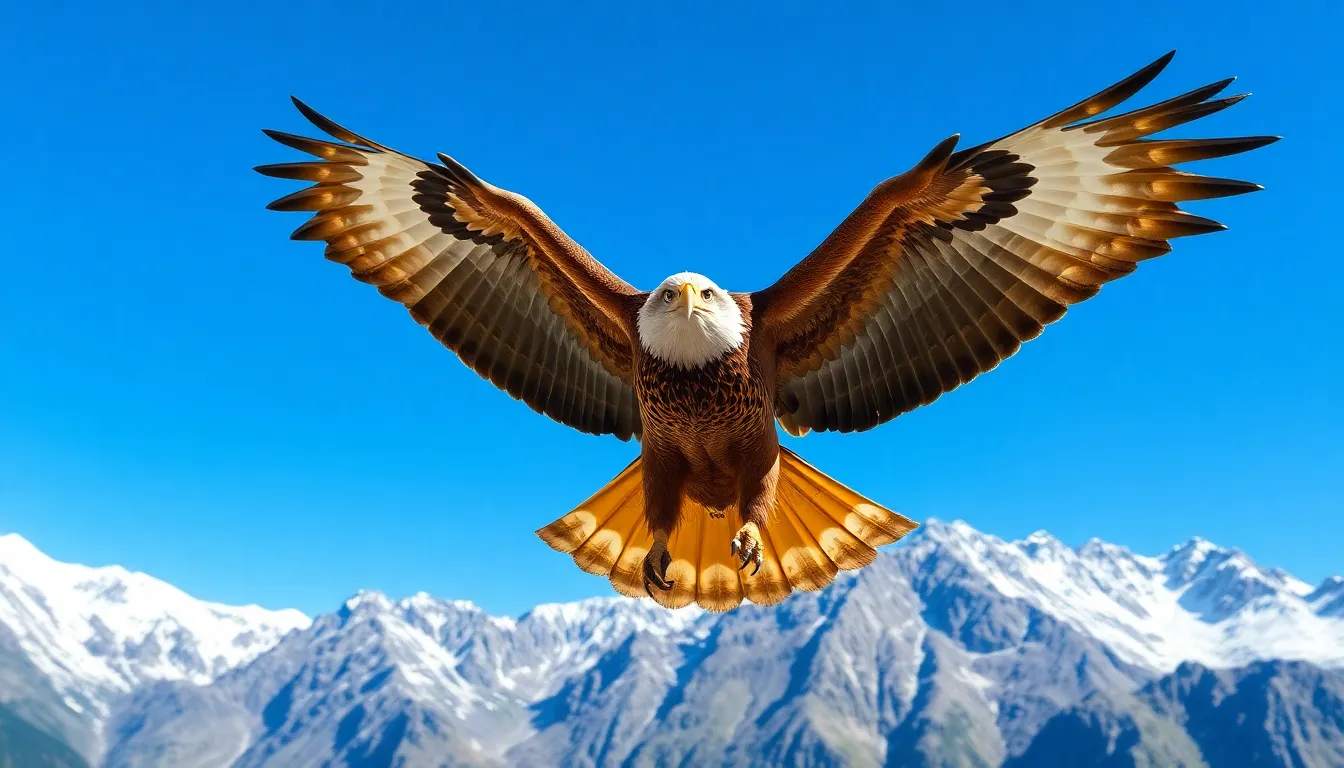
Different habitats present unique challenges that shape how birds adapt their flight techniques. We can witness remarkable variations in avian flight behavior by studying birds across diverse environments.
Urban Flying Adaptations
City dwelling birds demonstrate impressive flexibility in handling complex urban landscapes filled with obstacles and air turbulence. Pigeons excel at quick directional changes around buildings while house sparrows use short bursts of energy to dart between traffic lights and signage. Urban raptors like red-tailed hawks have adapted their hunting patterns to thermal currents created by concrete surfaces and building structures.
We observe that urban birds typically fly at lower altitudes to avoid tall structures while maintaining constant vigilance for obstacles. European starlings showcase remarkable coordination when flocking through narrow spaces between buildings during their evening roosts. Many city birds have developed enhanced spatial memory to navigate consistent routes through maze-like urban corridors.
Traffic noise and light pollution force urban birds to adjust their communication patterns during flight formation. American robins often fly in smaller groups through cities compared to their rural counterparts who form larger flocks. Building winds create unpredictable air currents that urban birds must constantly adjust to during flight.
Mountain and High-Altitude Flying
High altitude environments demand specialized physiological adaptations that enable birds to maintain efficient flight performance in thin air conditions. Golden eagles demonstrate superior soaring capabilities by utilizing mountain updrafts and ridge lifts to conserve energy while hunting across vast territories. Alpine species like white-tailed ptarmigan exhibit powerful wing beats to generate sufficient lift in low oxygen environments.
We notice that mountain birds often have larger heart sizes and enhanced blood oxygen capacity compared to their lowland relatives. Himalayan griffon vultures regularly soar above 20,000 feet (6,096 meters) by riding powerful thermal currents generated by mountain slopes. Bar-headed geese achieve remarkable altitude records during migration by flying over Mount Everest at heights exceeding 29,000 feet (8,839 meters).
Temperature fluctuations at high altitudes require mountain birds to adjust their flight patterns throughout the day. Mountain bluebirds time their foraging flights to coincide with optimal wind conditions and thermal activity. Snow and ice covered peaks create unique wind patterns that experienced alpine birds navigate with precision and efficiency.
Ocean and Water Flying Specialists
Marine environments present distinct flight challenges that have shaped the evolution of specialized wing designs and flight techniques among seabirds. Albatrosses master ever-changing soaring by utilizing wind gradients above ocean waves to travel thousands of miles without flapping their wings. Coastal species like brown pelicans demonstrate precise diving techniques by adjusting their wing angles moments before hitting the water surface.
We observe that seabirds possess waterproof feathers and specialized salt glands that enable extended flights over saltwater environments. Arctic terns showcase incredible endurance by maintaining steady flight speeds during their pole-to-pole migrations across vast ocean expanses. Shearwaters use a technique called slope soaring where they fly close to wave surfaces to take advantage of updrafts created by moving water.
Storm conditions over oceans test the flight capabilities of marine birds through powerful winds and turbulent air masses. Northern gannets adjust their diving angles and wing positions to maintain accuracy while fishing in rough seas. Seabirds often travel in loose formations that allow individual birds to respond quickly to changing wind conditions and feeding opportunities scattered across the ocean surface.
Understanding Factors That Affect Bird Flying
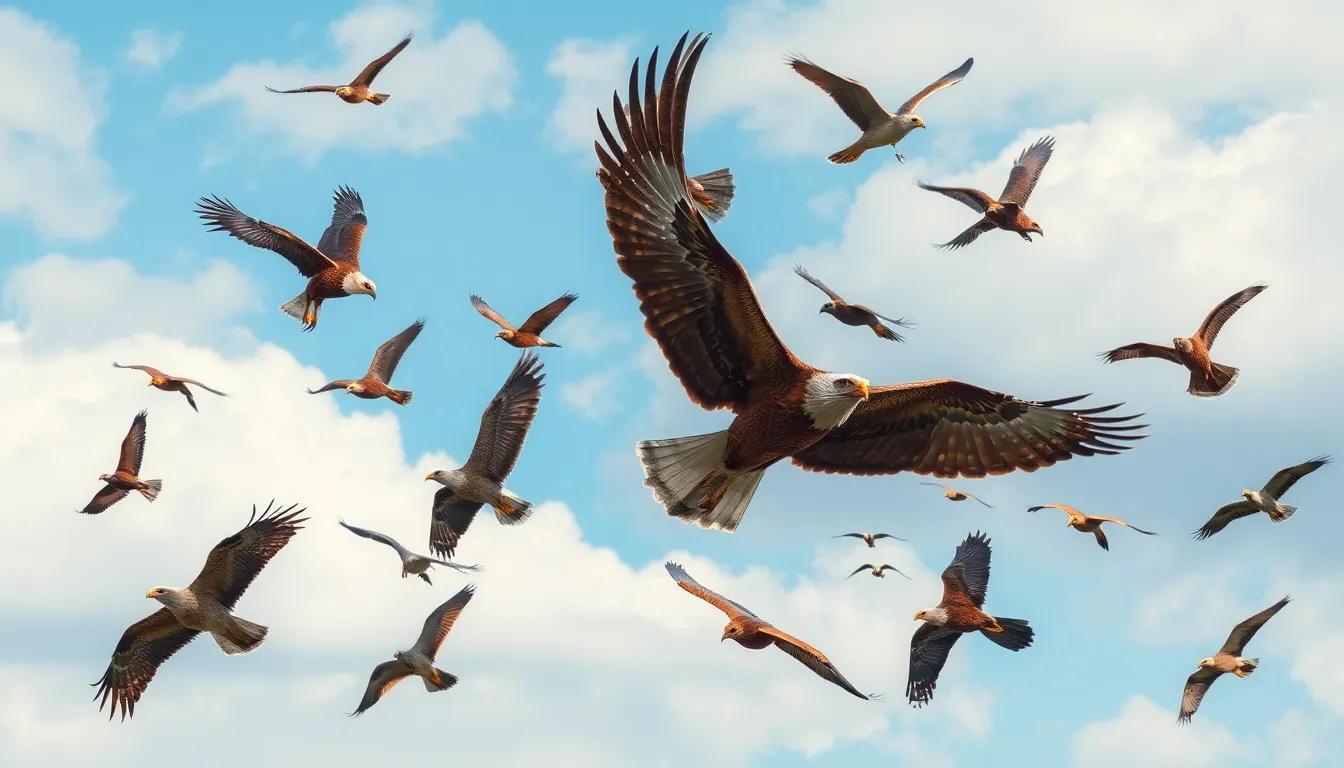
Several environmental and biological factors significantly influence how birds navigate the skies and adapt their flight patterns throughout their lives.
Weather Conditions and Flight
Wind patterns create both opportunities and challenges for flying birds across different environments. Tailwinds boost flight speed by up to 30% during migration, while strong headwinds can reduce progress by forcing birds to fly at lower altitudes or seek shelter. Crosswinds require constant adjustment in flight direction, causing birds like hawks and eagles to alter their wing positions for stability.
Precipitation affects bird flight performance in multiple ways, with rain reducing visibility and making feathers heavier. Light drizzle causes minimal disruption, but heavy rainfall forces most birds to seek immediate shelter since wet feathers lose their aerodynamic properties. Snow creates additional challenges by reducing lift generation and requiring more energy for sustained flight.
Temperature variations influence air density and thermal production, directly impacting soaring birds’ ability to gain altitude. Hot weather generates stronger thermals that benefit large soaring species like vultures and condors, while cold temperatures create denser air that requires more wing beats for smaller birds. Extreme heat forces many species to alter their daily flight schedules to avoid energy depletion.
Atmospheric pressure changes signal approaching weather systems, prompting birds to adjust their flight patterns accordingly. Low pressure systems create turbulent conditions that make flight more difficult, while high pressure areas provide stable air masses ideal for long distance travel. Birds often delay migration during rapidly changing pressure conditions to avoid dangerous flying weather.
Age and Flying Ability Development
Fledgling birds begin their flying journey with basic wing coordination and gradually develop advanced flight skills over several weeks. Young birds typically master short distance flights within 10 to 14 days after leaving the nest, but achieving full flight proficiency requires 4 to 8 weeks of practice. Parental guidance during this critical period helps fledglings learn essential techniques like landing, takeoff, and obstacle navigation.
Juvenile development involves progressive strengthening of flight muscles and refinement of wing control mechanisms. Birds between 3 to 6 months old show important improvements in flight endurance, with many species doubling their sustained flight time during this period. Wing loading ratios decrease as young birds develop stronger pectoral muscles, enabling more efficient flight patterns.
Adult prime performance occurs when birds reach full physical maturity, typically between 1 to 3 years depending on species size. Mature birds demonstrate optimal flight efficiency with fully developed respiratory systems supporting maximum oxygen delivery to flight muscles. This peak performance period can last 5 to 15 years in most species before age related decline begins.
Senior bird adaptations show decreased flight performance as aging affects muscle strength and cardiovascular capacity. Older birds compensate by choosing more efficient flight paths, reducing unnecessary aerial maneuvers, and spending more time in energy saving gliding patterns. Flight distances typically decrease by 20 to 30% in birds over 75% of their maximum lifespan.
Seasonal Changes in Flying Patterns
Spring migration patterns showcase dramatic increases in flight activity as birds return to breeding territories across North America and Europe. Departure timing varies by 2 to 4 weeks depending on weather conditions, with early migrants like red winged blackbirds arriving before late season travelers such as ruby throated hummingbirds. Breeding urgency drives more direct flight routes during spring compared to leisurely autumn journeys.
Summer flight behaviors focus on territorial defense, foraging efficiency, and raising young rather than long distance travel. Adult birds reduce flight distances by 60 to 80% during nesting season, concentrating their aerial activities within established home ranges. Parent birds increase flight frequency for food gathering, making up to 100 feeding trips daily for species like house wrens and chickadees.
Autumn migration strategies emphasize energy conservation and optimal timing to avoid harsh winter conditions. Birds build fat reserves comprising 20 to 50% of their body weight before beginning southward journeys, enabling extended flight periods without frequent stops. Weather patterns heavily influence departure schedules, with cold fronts triggering mass migration events across multiple species.
Winter survival adaptations require important changes in daily flight patterns as birds conserve energy during resource scarce months. Northern residents like cardinals and blue jays reduce flight distances by up to 70% compared to summer activity levels. Flocking behavior increases during winter months, with mixed species groups sharing information about food sources and safe roosting locations.
Appreciating the Evolution of Bird Flying
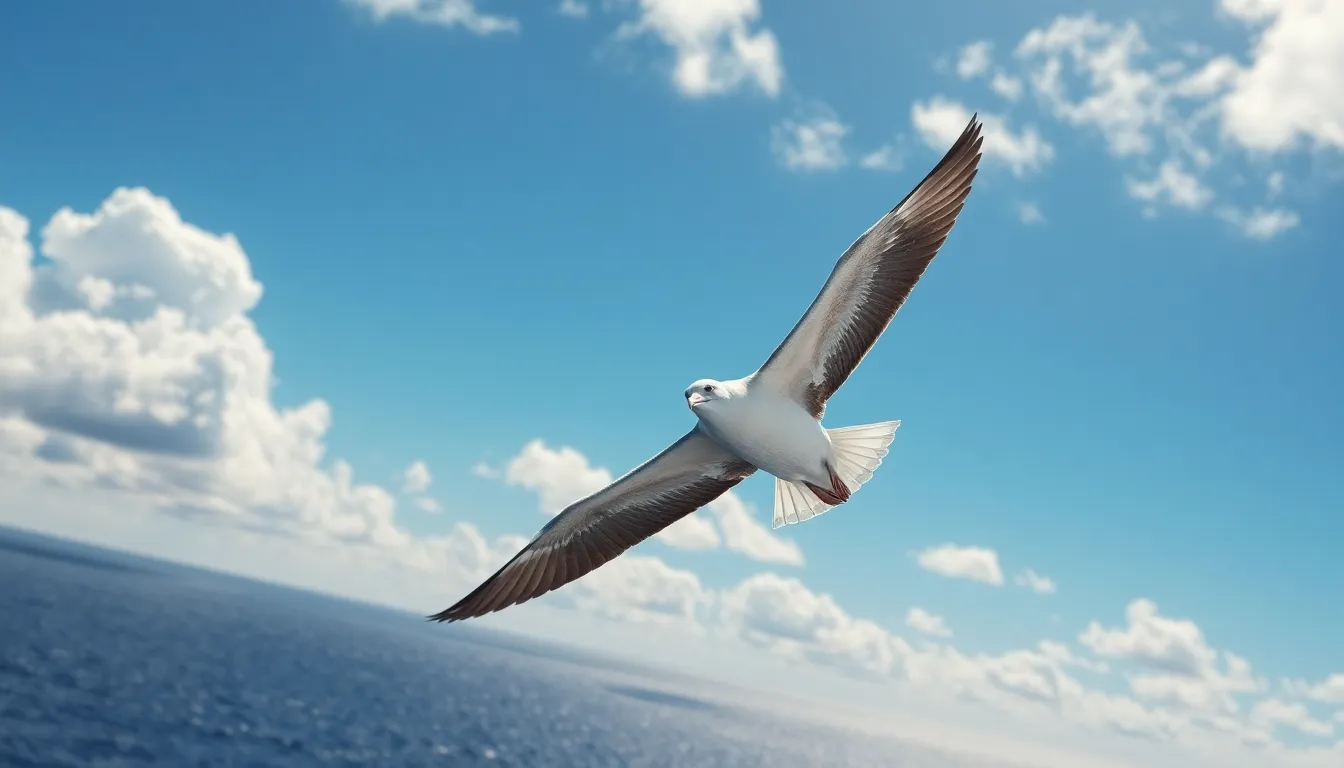
We’re witnessing the culmination of millions of years of evolutionary refinement when we observe modern birds in flight. This remarkable journey from ancient flying reptiles to today’s specialized aviators reveals nature’s incredible ability to perfect aerial locomotion.
Prehistoric Flying Birds
Archaeopteryx emerged 150 million years ago as one of the first feathered creatures capable of powered flight, though its flying abilities remained limited compared to modern birds. Scientists discovered that this transitional species possessed both reptilian features like teeth and claws alongside bird-like characteristics including feathers and wishbones.
Pterosaurs dominated prehistoric skies for over 160 million years, developing wingspans that reached up to 33 feet in species like Quetzalcoatlus. These ancient flyers used membrane wings stretched between elongated finger bones, creating a completely different approach to flight than what we see in modern birds.
Early bird species like Ichthyornis and Hesperornis lived alongside dinosaurs 100 million years ago, displaying various stages of flight development. Fossil evidence shows us that some retained teeth for catching fish while others had already evolved the lightweight beaks we recognize today.
Evolutionary Adaptations for Flight
Flight muscles underwent dramatic changes as birds evolved from their dinosaur ancestors, with the pectoralis major developing into the powerhouse that drives wing downstrokes. Modern birds dedicate 15-25% of their total body weight to flight muscles, while their prehistoric relatives managed with much smaller proportions.
Bone structure transformed through hollow pneumatic bones that reduce weight while maintaining strength, a feature absent in early flying creatures. We can trace this adaptation through fossil records showing gradual bone lightening over millions of years.
Feather evolution represents one of nature’s most sophisticated developments, progressing from simple filaments for insulation to complex flight instruments with barbules and hooks. Primary flight feathers developed asymmetrical designs that create lift more efficiently than the symmetrical feathers found on flightless birds.
Respiratory systems evolved into the unique flow-through design that allows birds to extract oxygen more efficiently than mammals during high-energy flight. This adaptation includes air sacs throughout the body that maintain constant airflow through the lungs during both inhalation and exhalation.
Modern Bird Flying Efficiency
Contemporary birds achieve remarkable fuel efficiency through refined wing designs that minimize energy expenditure during sustained flight. Albatrosses can soar for hours without flapping by utilizing ever-changing soaring techniques that harvest energy from wind gradients over ocean surfaces.
Wing loading optimization varies dramatically among modern species, with hummingbirds maintaining low wing loading for precise hovering while falcons develop high wing loading for maximum speed during hunting dives. These specialized adaptations allow each species to excel in their particular ecological niche.
Flight path efficiency reaches extraordinary levels in migrating birds that can navigate thousands of miles with pinpoint accuracy using multiple navigation systems. Bar-tailed godwits demonstrate this efficiency by flying nonstop for over 7,000 miles from Alaska to New Zealand, burning stored fat reserves with incredible precision.
Metabolic efficiency improvements include enlarged hearts that pump up to 1,000 beats per minute in small birds and specialized digestive systems that process food rapidly to fuel continuous flight. Modern birds can achieve energy conversion rates of up to 25% during flight, surpassing most mechanical engines in efficiency.
Conclusion
We’ve witnessed how millions of years of evolution have crafted the ultimate flying machines. Birds continue to inspire our understanding of flight dynamics and push the boundaries of what’s possible in aerial locomotion.
Every time we observe a bird in flight we’re seeing a masterpiece of biological engineering at work. From the precise coordination required for formation flying to the incredible endurance of long-distance migrants these creatures demonstrate nature’s ability to solve complex challenges through adaptation.
As we face our own environmental challenges birds offer valuable lessons about efficiency sustainability and resilience. Their remarkable flight abilities remind us that innovation often comes from studying the natural industry around us.
The next time you see birds soaring overhead take a moment to appreciate the extraordinary complexity and beauty of their aerial mastery. They’re living proof that flight isn’t just about getting from point A to point B – it’s about thriving in three-dimensional space with unmatched grace and precision.
Frequently Asked Questions
How do birds generate lift to fly?
Birds generate lift through their wing structure and aerodynamics. The curved shape of their wings creates pressure differences as air flows over and under them. The faster airflow over the top surface creates lower pressure, while slower airflow underneath creates higher pressure, resulting in lift that allows birds to become airborne and maintain flight.
What makes different bird species have different flying abilities?
Wing shape and body structure determine flying abilities. Eagles and hawks have broad wings for soaring, falcons have pointed wings for high-speed diving, and hummingbirds have short, rapidly-beating wings for hovering. Wing loading (body weight relative to wing area) also affects flight efficiency and maneuverability across different species.
How much of a bird’s body weight consists of flight muscles?
Flight muscles constitute a significant portion of a bird’s body weight, though the exact percentage varies by species and flight style. Birds that engage in more demanding flight patterns, such as hovering hummingbirds or long-distance migrants, typically have proportionally larger flight muscles to meet their higher energy demands.
How do birds navigate during long-distance migration?
Birds use multiple navigation methods including magnetic field detection, celestial navigation using the sun and stars, landmark recognition, and infrasound detection. These sophisticated systems work together to help birds like Arctic terns and bar-tailed godwits navigate thousands of miles during their remarkable seasonal migrations.
What is the fastest recorded bird flight speed?
The peregrine falcon holds the speed record, reaching 69 mph (111 km/h) in level flight and exceeding 240 mph (386 km/h) during hunting dives. The white-throated needletail can achieve 105 mph (169 km/h) in level flight, making it one of the fastest birds in sustained horizontal flight.
Why do birds fly in V-formation?
V-formation flying reduces energy expenditure by up to 20% during migration. The lead bird breaks through air resistance while creating beneficial updrafts for following birds. Birds rotate leadership positions to prevent exhaustion, making this formation one of nature’s most efficient methods for long-distance travel.
How do weather conditions affect bird flight?
Weather significantly impacts flight performance. Tailwinds enhance speed while headwinds and precipitation hinder progress. Atmospheric pressure changes cause birds to adjust flight patterns to avoid turbulence. Birds also time their migrations to take advantage of favorable weather conditions and seasonal wind patterns.
How do young birds learn to fly?
Fledgling birds gradually develop flying skills through practice and parental guidance. They start with short flights and progressively master complex maneuvers. Adult birds reach peak flight performance at physical maturity, while aging eventually affects flight efficiency, causing older birds to adapt their flight behaviors accordingly.
How have birds evolved their flight capabilities?
Bird flight evolved from ancient flying reptiles through millions of years of adaptation. Key evolutionary developments include specialized flight muscles, hollow bones for weight reduction, and advanced respiratory systems. Modern birds represent the culmination of this evolutionary process, exhibiting remarkable fuel efficiency and sophisticated navigation abilities.
How do different habitats influence bird flight techniques?
Habitat shapes flight adaptations significantly. Urban birds like pigeons navigate complex landscapes at lower altitudes. Mountain birds such as bar-headed geese have specialized adaptations for thin air. Seabirds like albatrosses evolved unique wing designs for oceanic environments, demonstrating remarkable adaptability across diverse ecosystems.

